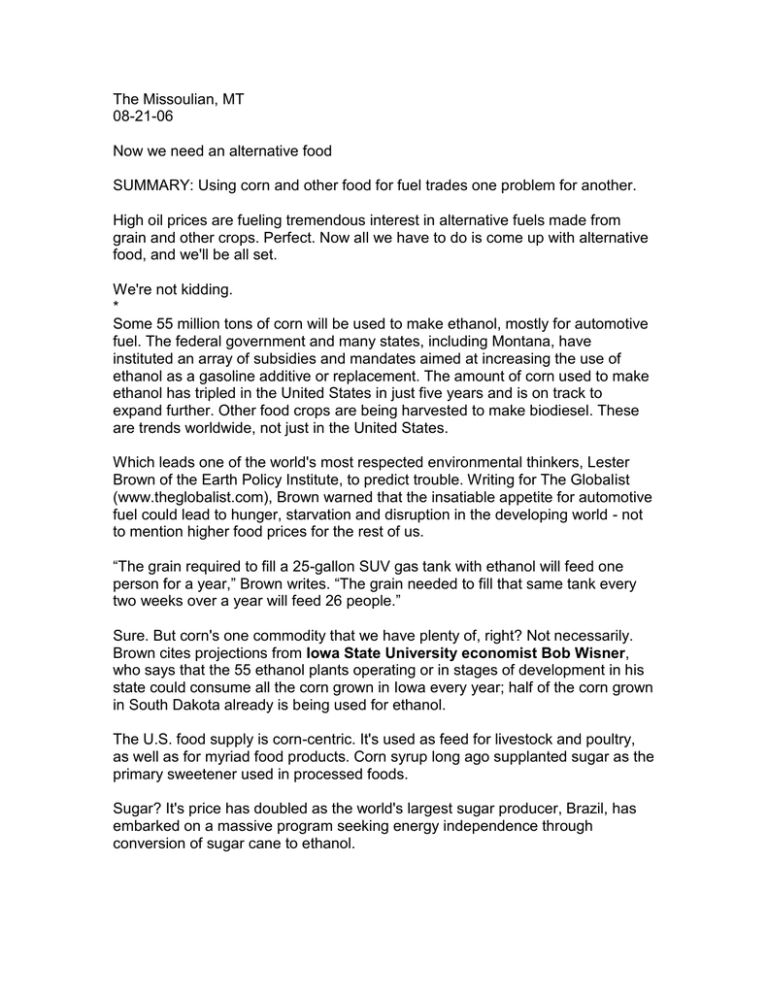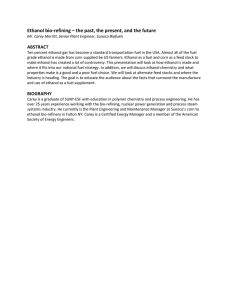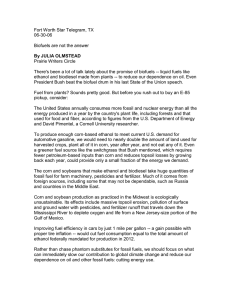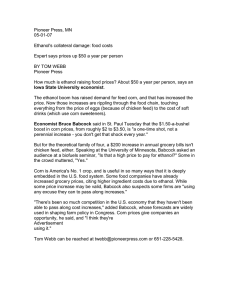The Missoulian, MT 08-21-06 Now we need an alternative food
advertisement

The Missoulian, MT 08-21-06 Now we need an alternative food SUMMARY: Using corn and other food for fuel trades one problem for another. High oil prices are fueling tremendous interest in alternative fuels made from grain and other crops. Perfect. Now all we have to do is come up with alternative food, and we'll be all set. We're not kidding. * Some 55 million tons of corn will be used to make ethanol, mostly for automotive fuel. The federal government and many states, including Montana, have instituted an array of subsidies and mandates aimed at increasing the use of ethanol as a gasoline additive or replacement. The amount of corn used to make ethanol has tripled in the United States in just five years and is on track to expand further. Other food crops are being harvested to make biodiesel. These are trends worldwide, not just in the United States. Which leads one of the world's most respected environmental thinkers, Lester Brown of the Earth Policy Institute, to predict trouble. Writing for The Globalist (www.theglobalist.com), Brown warned that the insatiable appetite for automotive fuel could lead to hunger, starvation and disruption in the developing world - not to mention higher food prices for the rest of us. “The grain required to fill a 25-gallon SUV gas tank with ethanol will feed one person for a year,” Brown writes. “The grain needed to fill that same tank every two weeks over a year will feed 26 people.” Sure. But corn's one commodity that we have plenty of, right? Not necessarily. Brown cites projections from Iowa State University economist Bob Wisner, who says that the 55 ethanol plants operating or in stages of development in his state could consume all the corn grown in Iowa every year; half of the corn grown in South Dakota already is being used for ethanol. The U.S. food supply is corn-centric. It's used as feed for livestock and poultry, as well as for myriad food products. Corn syrup long ago supplanted sugar as the primary sweetener used in processed foods. Sugar? It's price has doubled as the world's largest sugar producer, Brazil, has embarked on a massive program seeking energy independence through conversion of sugar cane to ethanol. President Bush, in his State of the Union address last winter, famously talked of turning to “switch grass” as feedstock for ethanol. Nobody eats that. Yet land devoted to growing switch grass - or any other crop for fuel - is land not used to produce food. Water, fertilizer, rail cars and anything else diverted from producing food to alternative energy also is likely to drive up food prices. Brown notes that, with 76 million more people to feed in the world each passing year, and with 2 billion people worldwide already spending more than half of their incomes on food, converting food to fuel may well prove to be a life-and-death matter. “The broader risk is that rising food prices could spread hunger and generate political instability in low-income countries that import grain, such as Indonesia, Egypt, Nigeria and Mexico,” he warns. “If ethanol distillery demand for gain continues its explosive growth, driving grain prices to dangerous highs, the U.S. government may have to intervene in the unfolding global conflict over food between affluent motorists and low-income consumers.” If you ask us, a war for corn isn't much more appealing than a war for oil. Actually, it doesn't have to happen. There are other alternatives to this particular alternative for oil, including synfuels from coal and nuclear energy. Yes, we know, there are problems with those energy sources - pollution and “greenhouse gasses” from the coal and radioactive waste disposal from nuclear. But there's no benign energy source. All forms of energy have problems associated with them. Reprocessing or long-term storage of nuclear waste are problems, but so are global famine and strife. There's one alternative that doesn't attract nearly the excitement of ethanol and biodiesel. It probably strikes many people as even less palatable than drilling the Arctic National Wildlife Refuge, burning coal, rebuilding Chernobyl or using food for fuel. It's called “conservation.” We could, though changes in lifestyle, business practices and technology, just use less energy. How much less? That 55 million tons of corn used for ethanol this year? It supplies just 3 percent of America's automotive fuel needs. It wouldn't take very much increased efficiency in cars, driving habits and energy use in general to save at least that amount of fuel. True, it's a whole lot more tempting to snatch cornmeal off the plates of starving children in Mexico or Africa than to slow down, drive less or (gasp!) buy a smaller car. But we should at least own up to the fact that, while ethanol is a relatively clean-burning fuel, it may not leave anyone with a cleaner conscience.









